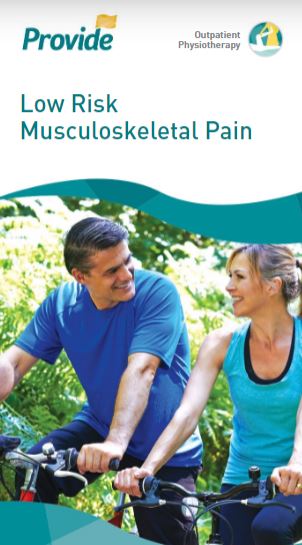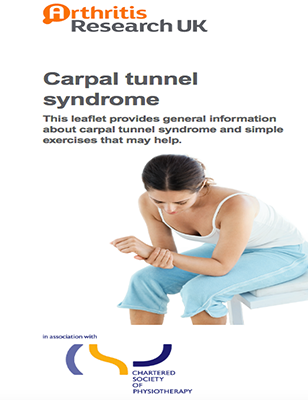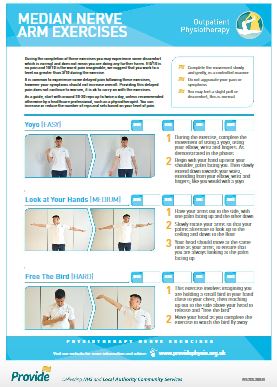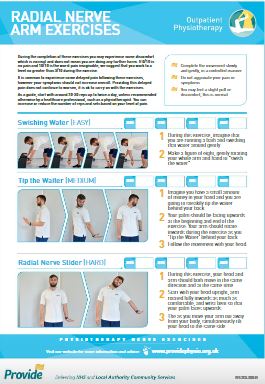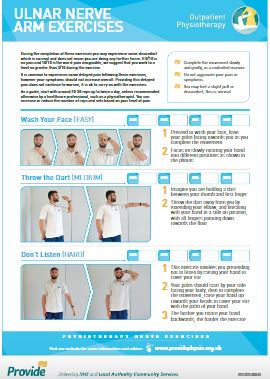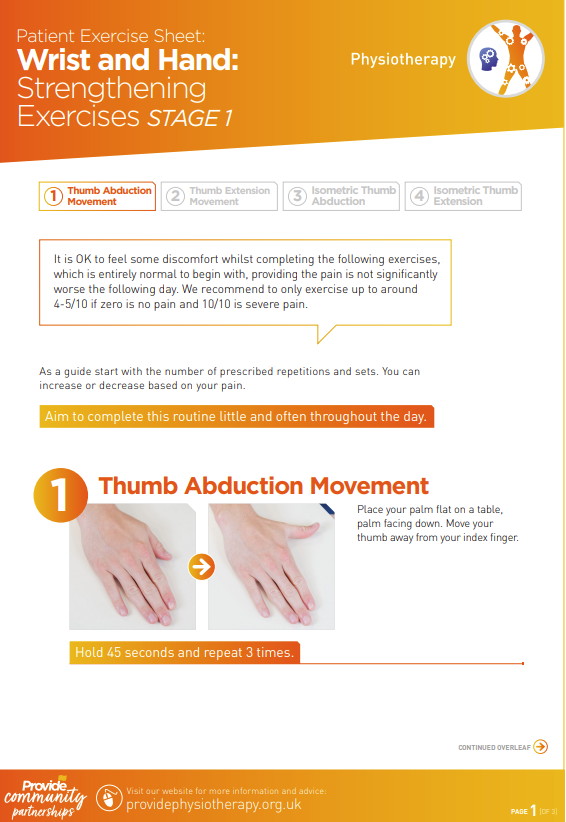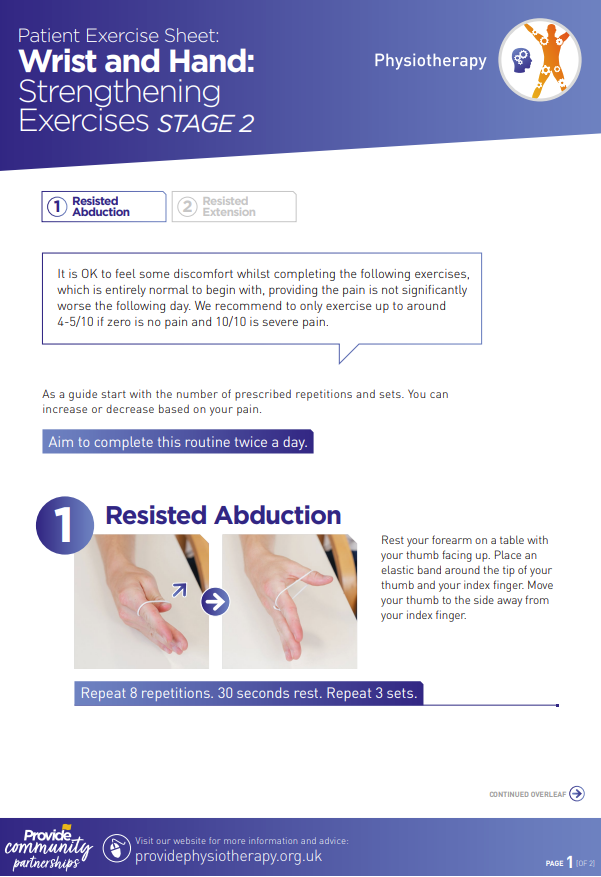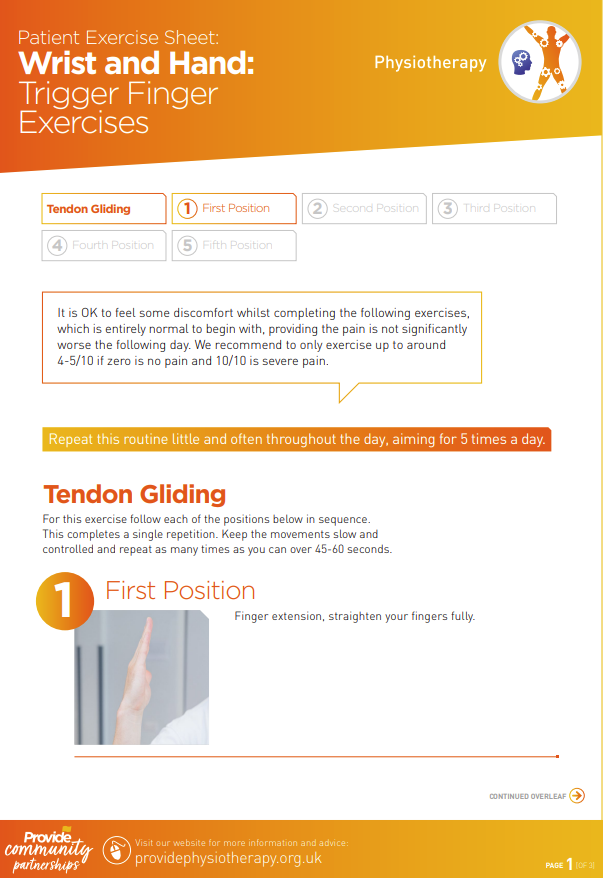Overview
The hand is a complex and multi-functional structure with numerous anatomical structures that can be the cause for wrist and hand pain including the joints, ligaments, tendons and nerves.
Different conditions will need slightly different management although often pain will improve with gradually returning to using the hand normally again.
Find out more about your wrist or hand pain in the other sections for further help.
If you are not sure of the cause of your wrist or hand pain then click below to complete our Musculoskeletal Symptom Checker to learn about potential causes of your symptoms and the best ways to manage these in the Self Help section.
Types of wrist and hand pain
This is a common injury if you have fallen with your arm outstretched and your wrist bent backwards.
There are many bones in the hand and wrist and these are connected by ligaments. Often these ligaments are overstretched but sometimes these ligaments may be partially or completely torn.
It is important to control the pain initially and you may need to reduce movements or use of your hand and wrist for the first few days, but after this it is very important to begin to move your wrist and hand regularly to prevent it from getting stiff; click here for exercises that assist with the movement and mobility of your wrist hand and wrist.
As the pain improves you can begin strengthening your hand and wrist again and return to normal activities. Click here for early stage strengthening exercises recommended by our therapists.
This is a very common condition and it is important to be aware that pain from osteoarthritis does not correlate to the severity of damage in the joint. The joints at the base of the thumb and ends of the fingers are frequently affected as we use these joints regularly in everyday life.
You may experience pain when using your joint or pain that is worse by the end of the day. Osteoarthrtis can cause stiffness; often this stiffness is worse after rest and improves quickly with movement and this is why it is important you don’t avoid moving the painful joint.
For a range of mobility exercises that can assist with the movement of your wrist please click here.
Click Here for further information on Osteoarthritis and ways to manage it effectively.
Carpal tunnel syndrome tends to cause pins and needles or numbness in the thumb, index and middle finger, this is because a nerve called the median nerve is irritated at the wrist. The median nerve carries information about the sensation in your thumb and fingers and controls some of the muscles in the hand. It is important to seek help if you notice weakness in your hand muscles.
Carpal tunnel can be related to other conditions such as thyroid disease, pregnancy or be related to pain in your neck. Symptoms tend to come on gradually and may be worse at night or first thing in the morning. Some people won’t notice it during the day but repetitive activities such as writing, typing, and housework can bring on the symptoms.
In many people, carpal tunnel syndrome will get better by itself. If there is a particular cause such as an underactive thyroid treating this condition may help. Different people respond to different treatments for carpal tunnel, modifying repetitive activities at work or home may help but it is important to continue to move and use your hand and wrist regularly, as not using your hand is more likely to increase the pain you are experiencing.
Some people may require prescribed medication or a steroid injection to help with pain as well as carrying out exercises. In severe cases, which are not improving with other treatments, surgery may be required. Click here for exercises to help with Carpal Tunnel Syndrome and also see the Self Help section for further information and also see the Self Help section for further information.
If you are experiencing pain at the base of your thumb and mild swelling over the outside of your wrist where it meets your thumb you may have developed De Quervain’s Tenosynovitis.
Tendons join our muscles to bones, at the thumb there are a number of tendon that help to moving the wrist towards the thumb and the thumb away from the palm. In people who use the hand repetitively for activities such as typing or gripping over time the tendons can become irritated and cause pain. It is important you do not avoid using your hand as complete rest is not recommended. You may however need to modify the repetitive tasks you are doing. Click here for exercises that will help with keeping your wrist and hand moving.
Exercises can help to strengthen your tendon and resolve the pain, see this link. Some people may require prescribed medication or a steroid injection.
If you have noticed it has become difficult to bend your finger or thumb and you experience a catching or clicking sensation at the base of your finger or thumb it is possible you are experiencing trigger finger. It may cause your finger to get stuck and then suddenly pop back to straight.
Tendons join our muscles to bones. In the palm tendons run along our fingers to allow us to bend our fingers, these are called our flexor tendons. A sheath with a small amount of fluid covers the tendon allowing the tendon to move freely when we bend or straighten our fingers. If there is a problem with the sheath or tendon, the tendon can no longer move freely and can bunch up causing a small lump called a nodule to appear.
Trigger finger is more common if you suffer from diabetes. Not everyone with trigger finger will need treatment; in some cases it will get better by itself. Some people may require a steroid injection by either your doctor or physiotherapist.
To see the exercises that our physiotherapists recommend for trigger finger, please click here.
Is my wrist or hand pain likely to persist?
Take our one minute test
This quick questionnaire can help you identify how likely your pain is to persist over the next 6 months and whether you may need some extra support. It has been developed by a team of experts from Keele University – Click here for more information about the tool.
The tool has been shown to be very useful for people with common Musculoskeletal pain to profile individual risk of having a poor recovery and to use as a guide in conjunction with support from a healthcare professional if necessary.
Try out the questionnaire for yourself to see how you score and to get further help and advice. It will also be useful to retake the questionnaire after you have learned more key facts about your pain, either from this website or from a healthcare professional, to re-assess in time whether your wrist and hand pain problem is improving.
| For question 1 – 9, think about just the last two weeks: |
|---|
| Pain intensity 1. On average, how intense was your pain? [where 0 is “no pain”, 10 is “pain as bad as it could be”] |
| Select one of the options for each question below | Yes | No |
|---|---|---|
| 2. Do you often feel unsure about how to manage your pain condition? | ||
| 3. Over the last 2 weeks, have you been bothered a lot by your pain? | ||
| 4. Have you only been able to walk short distances because of your pain? | ||
| 5. Have you had troublesome joint or muscle pain in more than one part of your body? | ||
| 6. Do you think your condition will last a long time? | ||
| 7. Do you have other important health problems? | ||
| 8. Has pain made you feel down or depressed in the last two weeks? | ||
| 9. Do you feel it is unsafe for a person with a condition like yours to be physically active? | ||
| 10. Have you had your current pain problem for 6 months or more? |
High Risk
This test suggests you have some serious concerns about how well your wrist or hand pain will recover.
This may be related to feeling low and anxious generally or by being afraid that you might have done something serious to your wrist or hand.
It might help to discuss your concerns with a doctor or physiotherapist if things are still not improving over the next few weeks after following the advice and exercise in the Self Help section.
Also, visit the section on Persistent Pain for more information and support.
Most wrist or hand problems are not related to a serious condition. Allowing yourself to move normally, without too much worry, will help your wrist or hand to return to normal.
Painkillers often help you to move normally, while your wrist or hand recovers.
If you are feeling low or anxious, whether this I related to your wrist or hand pain or not, and you would like further help and support, visit NHS website – Health in Mind.
Alternatively, Click Here for an interactive online self-help programme to help manage symptoms of depression and anxiety.
Medium Risk
This test suggests you may have some doubts about how well your wrist or hand pain will recover.
This may be related to feeling low and anxious generally or by being afraid that you might have done something serious to your wrist or hand.
It might help to discuss your concerns with a doctor or physiotherapist if things are still not improving over the next few weeks after following the advice and exercise in the Self Help section.
Most wrist and hand problems are not related to a serious condition.Allowing yourself to move normally, without too much worry, will help your wrist or hand to return to normal.
Painkillers can help you to move normally, while your wrist or hand recovers.
You might also want to access the Essex Lifestyle Service for further support and help on making healthy lifestyle choices and live healthier lives as this could be contributing to your wrist or hand pain.
Low Risk
Congratulations! You most likely have the right ideas about your wrist or hand pain, and feel in control of how you manage your recovery.
We all know an episode of wrist or hand pain is very annoying, and at times extremely painful. Carrying on as normal and continuing to move your wrist or hand allows the quickest recovery, and stops your wrist or hand stiffening up and losing strength.
Keep going as you are, although read this short leaflet for more information and advice to get better even quicker.
You might also want to access the Essex Lifestyle Service for further support and help on making healthy lifestyle choices and live healthier lives as this could be contributing to your wrist or hand pain.
Self help
Evidence has shown that people who understand their Musculoskeletal health problem and take an active involvement to help themselves have a much better outcome.
Here are some really helpful leaflets, exercises and useful links to other websites that have been approved by our physiotherapists so that you can start getting better with your wrist and hand pain today.
This information is not intended or implied to be a substitute for professional medical advice, diagnosis or treatment if required. All content is for general information purposes only.
leaflets
Exercises
Useful Links
- Helpful information by selecting which area of your wrist or hand hurts to find out more including common causes, ‘ do’s and don’ts ‘ to ease wrist or hand pain yourself as well as when to seek medical advice.
- 10 Exercises that can be effective for treating De Quervain’s Tenosynovitis– Why not try them today?
Further Support
If your wrist or hand pain is still not improving despite following the advice and guidance provided on the website and you score a ‘Medium’ or ‘High Risk’ when completing the ‘Is my wrist or hand pain likely to persist?‘, you may require further help and support from the Physiotherapy Service. Please click on the ‘Physiotherapy Self-Referral’ box to refer yourself to the service for further management of your back problem.
Following trauma to the hand or wrist (e.g. falling and placing your hand down first) it is possible you might have injured one of the bones in your forearm or hand and need an x-ray. If you experience the following symptoms following trauma, you should seek further medical advice straight away:
- Immediate pain when you try to move your hand or wrist,
- Immediate pain when you try to touch the area,
- Immediate pain when you try to grip objects.
It is important to remember if you have not had a trauma and experience these symptoms it is unlikely you have injured your bones.
Contact NHS 111 or seek urgent medical care if you think you may have broken your wrist. Click here for further guidance.
FAQs
- A trauma to the area
- Immediate pain when you try to move your hand or wrist.
- Immediate pain when you try to touch the area.
- Immediate pain when you try to grip objects.

